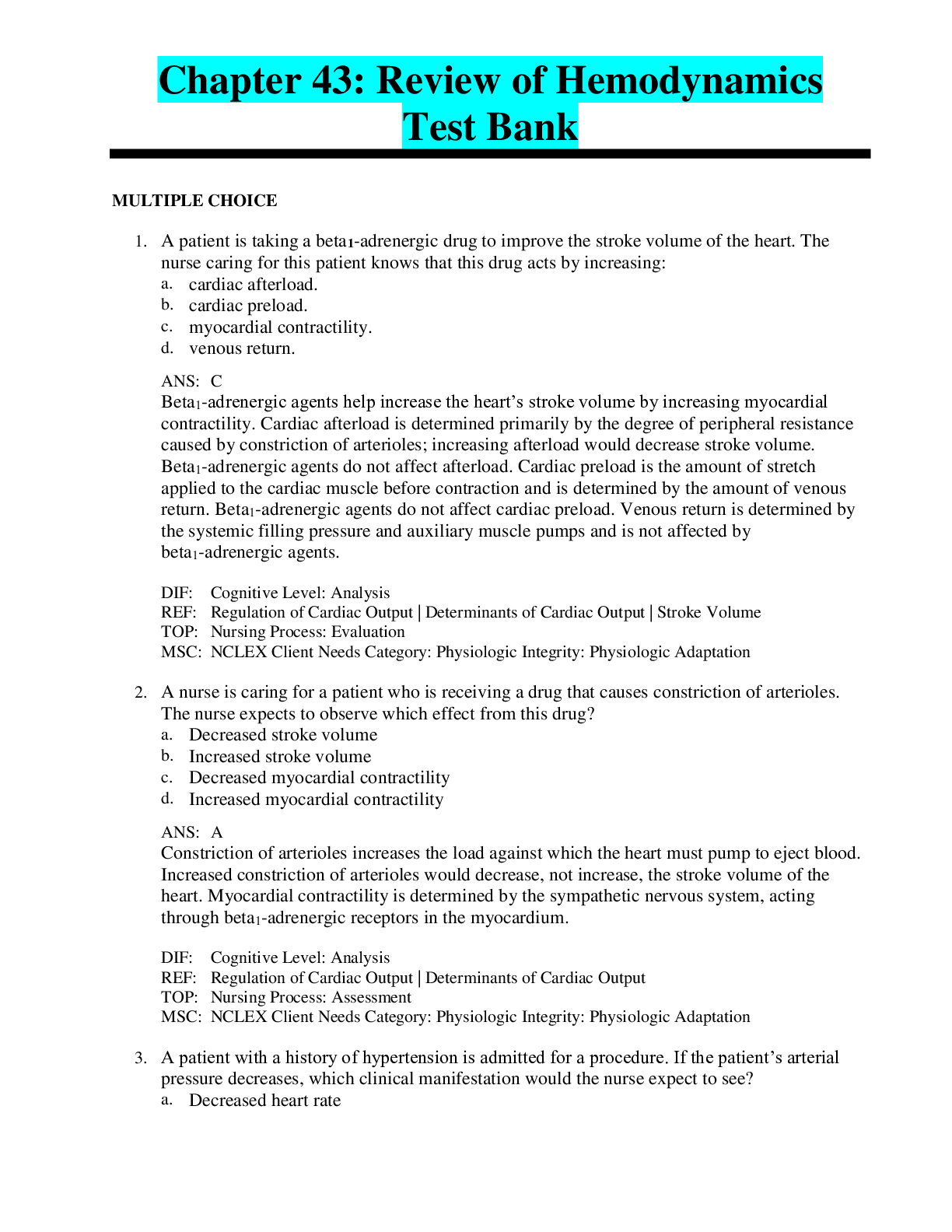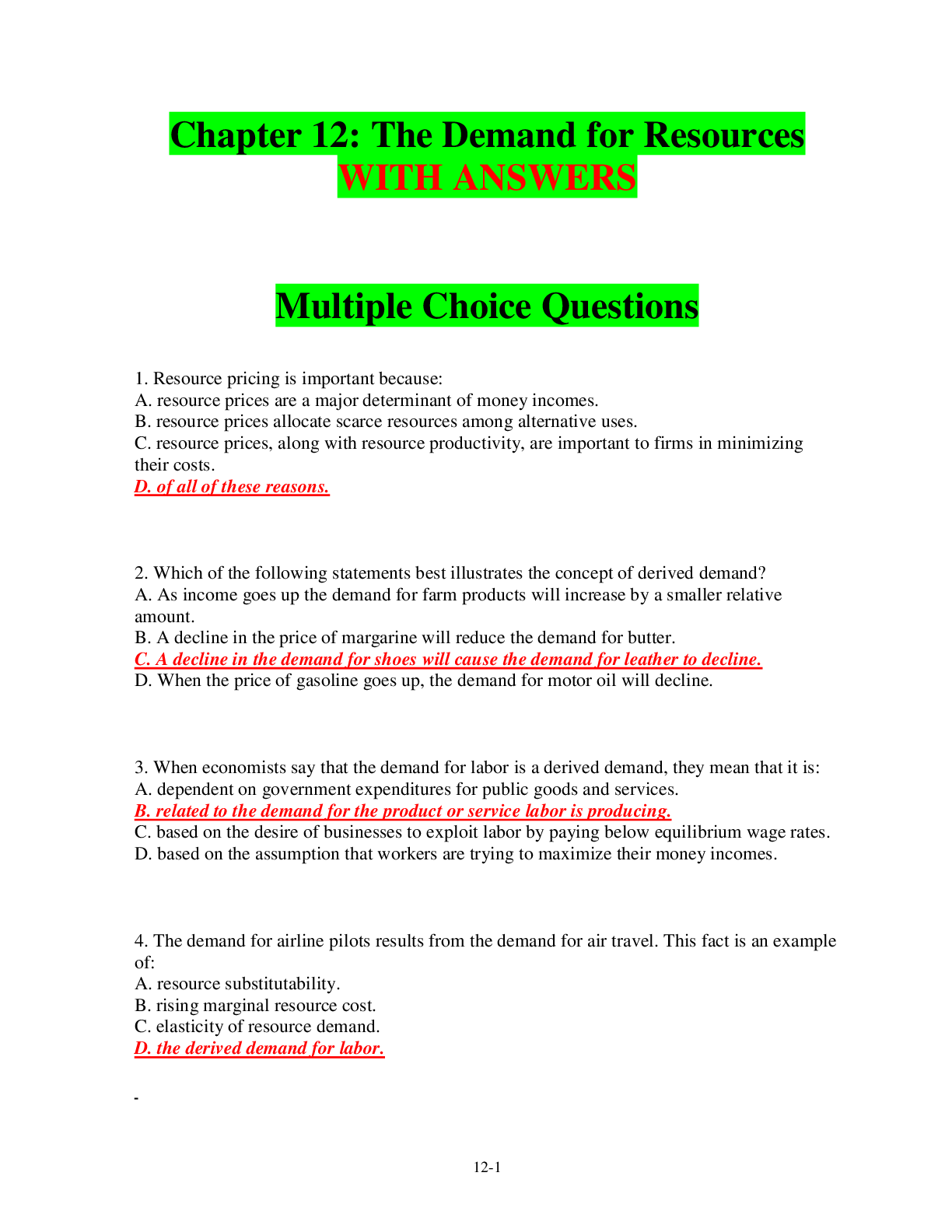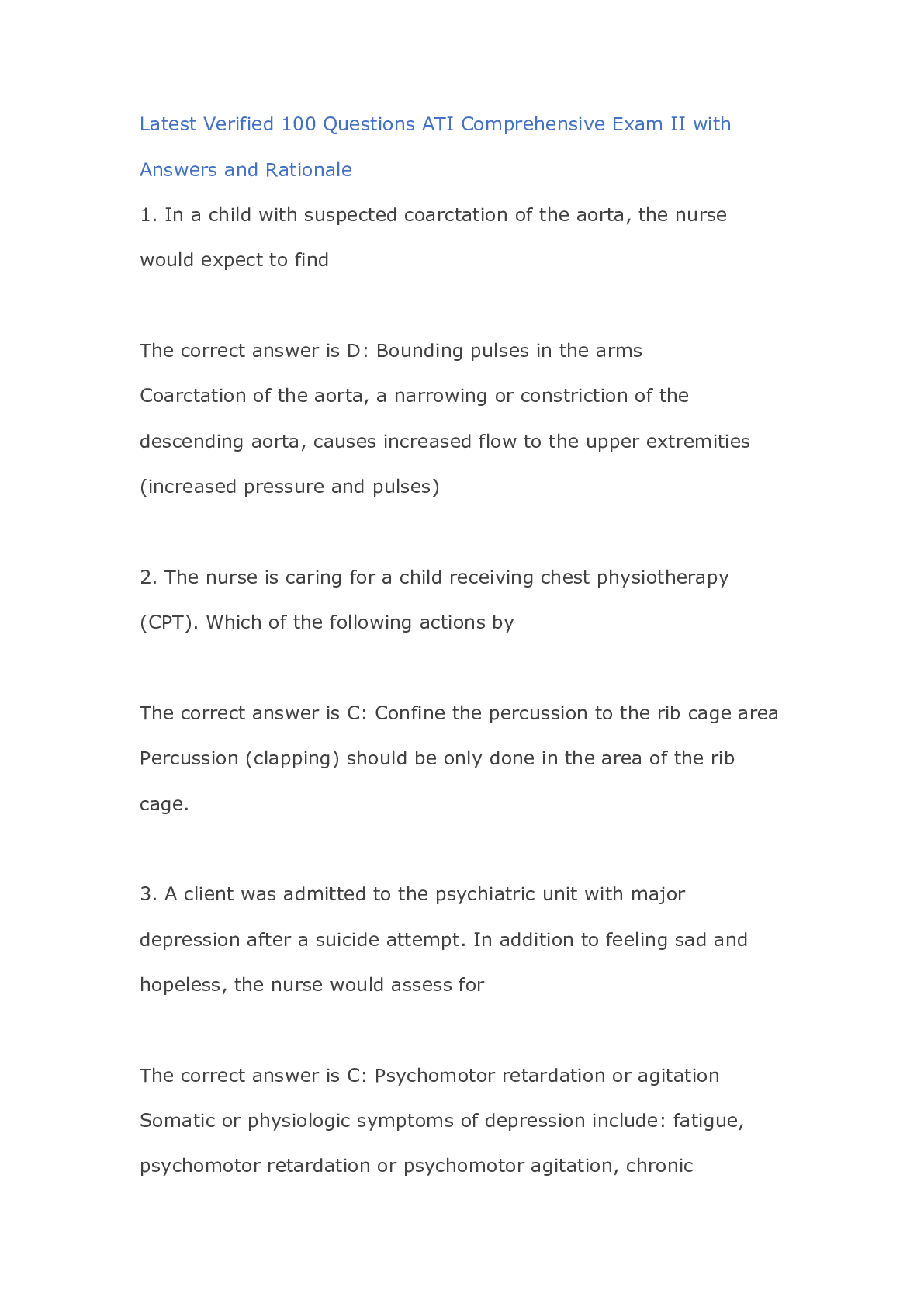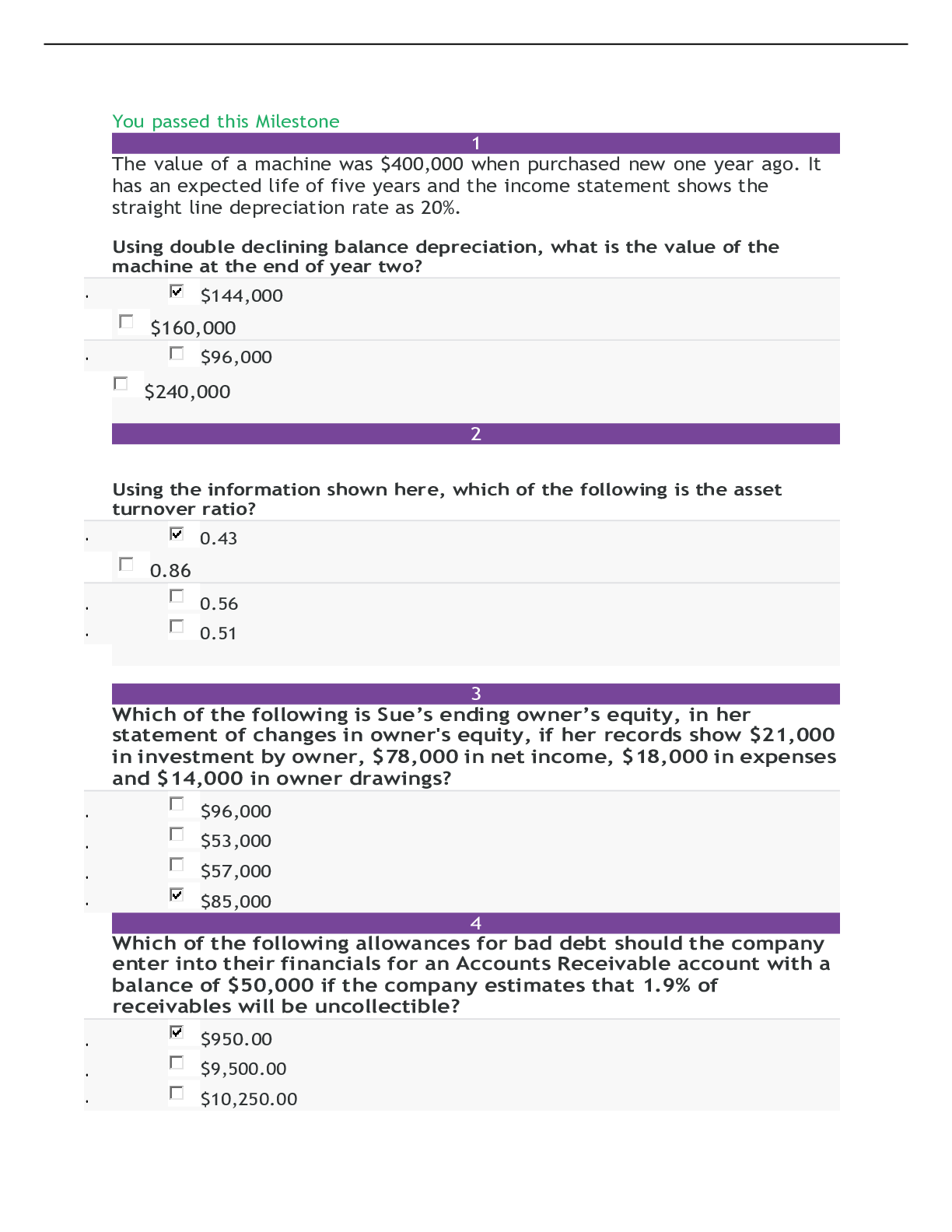*NURSING > QUESTIONS & ANSWERS > South University, Savannah - NURSING 6005Pharm Quiz 9. 100% With answer Responses (All)
South University, Savannah - NURSING 6005Pharm Quiz 9. 100% With answer Responses
Document Content and Description Below
NURSING 6005Pharm Quiz 9: Anemia, Sickle Cell ANSWER-RESPONSE AT THE END QUESTION 1 1. Intravenous carmustine has been prescribed for a patient with cancer. The nurse should help relieve the disc... omfort of pain and burning during the infusion by 2. A. decreasing the volume used for dilution. B. decreasing the total volume of the primary IV infusion. C. slowing the infusion. D. administering a dose of 2 units of bleomycin before carmustine. 1 points QUESTION 2 1. When planning care for a patient who is receiving filgrastim (Neupogen) for a nonmyeloid malignancy, the nurse should formulate which of the following patient outcomes? (Select all that apply.) 2. A. The patient will not develop febrile neutropenia. B. The patient will not develop an infection. C. The patient will not experience bone pain. D. The patient will be able to self-administer filgrastim at home. E. The patient will not retain fluid. 1 points QUESTION 3 1. A patient's current course of cancer treatment involves the administration of a conjugated monoclonal antibody. What characteristic of the drug is specified by the fact that it is classified as a conjugated drug? 2. A. The targeted therapy is combined with another substance that causes cell death. B. The drug is derived from nonhuman sources. C. The targeted therapy is combination of a monoclonal antibody, a kinase inhibitor, and an inorganic cytotoxin. D. The drug is able to adapt its pharmacokinetics to the etiology of the patient's cancer. 1 points QUESTION 4 1. Mr. Lepp is a 63-year-old man who was diagnosed with colon cancer several weeks ago and who is scheduled to begin chemotherapy. He reports to the nurse that he read about the need for erythropoietin in an online forum for cancer patients and wants to explore the use of epoetin alfa with his oncologist. Which of the following facts should underlie the nurse's response to Mr. Lepp? 2. A. Mr. Lepp's oncologist should have begun treatment with epoetin alfa immediately after he was diagnosed. B. The potential benefits of epoetin alfa must be weighed carefully against the potential adverse effects in cancer patients. C. Treatment with epoetin alfa will likely begin 4 to 6 days before Mr. Lepp's first round of chemotherapy and continue indefinitely. D. Epoetin alfa is normally contraindicated in patients who are receiving radiotherapy or chemotherapy. 1 points QUESTION 5 1. A 39-year-old woman is receiving doxorubicin for the treatment of cancer. After each treatment, the patient has acute nausea and vomiting accompanied by a slightly increased heart rate. The nurse will advise her to 2. A. make an appointment for cardiac function tests. B. perform light exercise after administration of the drug. C. take the drug only at bedtime. D. perform relaxation techniques after the treatments. 1 points QUESTION 6 1. A nurse is administering rituximab to a patient via the IV route. The nurse will set the IV pump at 50 mg/hour for the first half hour of the initial infusion. If there are not apparent reactions after 30 minutes of the infusion, the nurse will increase the dosage every 30 minutes by 50 mg/hour until the maximum infusion rate reaches which of the following? 2. A. 400 mg/hour B. 250 mg/hour C. 500 mg/hour D. 300 mg/hour 1 points QUESTION 7 1. An oncology nurse is reviewing the pathophysiology of cancer and is discussing with a colleague the factors that contribute to the success or failure of a patient's chemotherapy. Which of the following cancerous cells is most susceptible to the effects of chemotherapeutic drugs? 2. A. Cells with a long generation time B. Cells that lack a blood supply C. Cells that lack contact inhibition D. Cells that have a rapid mitotic rate 1 points QUESTION 8 1. A nurse is caring for a patient with cancer who has been prescribed dronabinol (Marinol) to help reduce nausea and vomiting from chemotherapy. The nurse will inform the patient that he or she is taking an oral form of 2. A. nicotine. B. marijuana. C. methamphetamine. D. cocaine. 1 points QUESTION 9 1. A female patient is prescribed oprelvekin therapy to treat thrombocytopenia. Which of the following should the nurse continuously monitor to determine the efficacy and duration of the oprelvekin therapy? 2. A. Red and white blood cell count B. Cardiac arrhythmias C. Weight gain D. Platelet count 1 points QUESTION 10 1. A nurse has been assigned to a 55-year-old woman who has a malignant brain tumor. The patient is receiving her first dose of carmustine. It will be critical for the nurse to observe for which of the following? 2. A. Respiratory difficulty B. Reddish urine C. Inability to drink fluids for 6 hours D. Nausea and vomiting 1 points QUESTION 11 1. A 45-year-old woman with acute leukemia is going to begin chemotherapy with vincristine. The nurse is aware that vincristine must always be administered 2. A. through a central line. B. through an IV line primed with vincristine. C. at a rapid infusion rate. D. at a slow infusion rate. 1 points QUESTION 12 1. A patient with chronic heart failure has begun treatment with epoetin alfa, which she will receive in her own home from a home health nurse. The nurse should teach the patient to supplement this treatment with a diet that is high in 2. A. iron-rich foods such as beans and leafy green vegetables. B. protein and low in carbohydrates. C. calcium, such as dairy products, fish and vegetables. D. complex carbohydrates and vegetable-source proteins. 1 points QUESTION 13 1. A nurse has been assigned to a female patient who is to begin chemotherapy. The nurse will initiate the prescribed oprelvekin therapy 2. A. 10 days after chemotherapy. B. 2 days after chemotherapy. C. 6 days after chemotherapy. D. 6 to 24 hours after chemotherapy. 1 points QUESTION 14 1. An oncology nurse is aware of the risks for injury that exist around the preparation, transportation, and administration of chemotherapeutic agents. In order to reduce these risks of injury, the nurse should take which of the following actions? 2. A. Encourage patients who have been receiving chemotherapy to use a bedside commode rather than a toilet. B. Prime the IV tubing with an approved IV solution rather than with the drug itself. C. Dispose of intravenous lines used for chemotherapy administration in a covered trash can in the patient's room. D. Use an IV system for administration that includes needles to reduce the risk of accidental spills. 1 points QUESTION 15 1. A patient will soon begin targeted therapy as a component of her treatment plan for chronic leukemia. The nurse is conducting health education about this new aspect of the patient's drug regimen and the patient has asked about the potential side effects of treatment. How should the nurse best respond? 2. A. “Both classes of drugs have adverse effects, but targeted therapies tend to have less of an effect on healthy body cells.” B. “The adverse effects to targeted therapies are most often a result of the patient's cancer, not the drugs themselves.” C. “Targeted therapies are often more effective than traditional chemotherapy, but the downside of this effectiveness is that adverse effects are more common and severe.” D. “Chemotherapy causes a lot of unpleasant side effects, and the advantage of targeted therapies is that these are all avoided.” 1 points QUESTION 16 1. A middle-aged patient has received a diagnosis of GI stromal tumor following an extensive diagnostic workup. Imatinib has been recommended as a component of the patient's drug regimen. What patient education should the nurse provide to this patient? 2. A. “Try to keep your PICC line dressing as dry as possible at all times.” B. “If you experience significant nausea after taking a dose, stop taking the drug and schedule an appointment at the clinic.” C. “You'll likely experience a lot of dry mouth while you're taking this drug, so it's helpful to chew ice chips.” D. “It's important that you let us know if you develop any significant swelling or puffiness.” 1 points QUESTION 17 1. A male patient is receiving rituximab therapy for non-Hodgkin's lymphoma. Which of the following would be a priority nursing intervention to reduce the risk for cytotoxicity and tumor lysis syndrome? 2. A. Ensure that the patient maintains a normal breathing pattern. B. Protect the patient from exposure to infections. C. Monitor the patient for deterioration in renal function. D. Ensure that the patient maintains a normal fluid and electrolyte balance. 1 points QUESTION 18 1. A 67-year-old man who is being treated for prostate cancer is taking epoetin alfa. The nurse will instruct the patient to 2. A. stop taking the drug after a 2-week period. B. begin taking a calcium channel blocker to treat hypertension, which usually develops as an adverse effect of epoetin alfa therapy. C. schedule an appointment to measure hemoglobin twice a week for at least 2 to 6 weeks. D. schedule an appointment to check if the patient has a high WBC count. 1 points QUESTION 19 1. A nurse has completed a medication reconciliation of a patient who has been admitted following a motor vehicle accident. Among the many drugs that the patient has received in the previous year is rituximab. The nurse would be justified in suspecting the patient may have received treatment for which of the following diseases? 2. A. Nonsmall cell lung cancer B. Non-Hodgkin's lymphoma C. Malignant melanoma D. Renal cell carcinoma 1 points QUESTION 20 1. A nurse is discussing oprelvekin therapy with a male patient. Which of the following will the nurse tell the patient is the most common adverse effect of the drug? 2. A. Medullary bone pain B. Papilledema C. Fluid retention/weight gain D. Atrial arrhythmia 1 points QUESTION 21 1. A patient with a recent diagnosis of chronic myelogenous leukemia (CML) is discussing treatment options with his care team. What aspect of the patient's condition would contraindicate the use of cyclophosphamide for the treatment of leukemia? 2. A. The patient has decreased renal function. B. The patient has had a history of nonadherence to medical treatment. C. The patient's bone marrow function is significantly depressed. D. The patient has a diagnosis of type 2 diabetes and takes oral antihyperglycemics. 1 points QUESTION 22 1. A patient has completed 4 weeks of treatment with epoetin alfa. Which of the following assessment findings would most strongly indicate that treatment has been effective? 2. A. The patient maintains an oxygen saturation of 92% on room air B. Capillary refill in the patient's nail beds is less than or equal to 3 seconds C. The patient's hemoglobin level is 11 g/dL D. The patient white blood cell level is within reference ranges 1 points QUESTION 23 1. A nurse on an oncology unit is aware of the need to assess for adverse effects in patients who are being treated with rituximab. The risks of adverse effects are highest at what point during the course of treatment? 2. A. Shortly after the initiation of the first infusion of rituximab B. After 6 to 8 weeks of treatment at the maximum dose C. At each point that the dosage of rituximab is increased D. 48 to 72 hours after the first dose has been administered 1 points QUESTION 24 1. A 28-year-old woman has completed rituximab therapy for an autoimmune disease. She tells the nurse that she and her husband would like to start a family. The nurse will advise her to 2. A. pursue fertility testing. B. continue using birth control for at least 12 months. C. stop using birth control for the next several weeks. D. discontinue birth control, but avoid breast-feeding after the child is born. 1 points QUESTION 25 1. Which of the following patients will be at the greatest risk for anemia and would be the most likely candidate for epoetin alfa therapy? 2. A. A 20-year-old female B. A 30-year-old pregnant woman C. A 62-year-old male with cancer D. A 40-year-old male with a high white blood cell count 1 points QUESTION 26 1. Mr. Singh is a 66-year-old man who is receiving chemotherapy for the treatment of lung cancer that has metastasized to his liver. In an effort to prevent infection, Mr. Singh has been prescribed filgrastim (Neupogen). Which of the nurse's following assessment questions most directly addresses a common adverse effect of filgrastim? 2. A. “Do you feel like you're having any pain in your bones?” B. “Have you noticed any bleeding in your gums or cheeks?” C. “Are you experiencing any waves of cool, clammy skin?” D. “Have you had any shortness of breath lately?” 1 points QUESTION 27 1. A nurse is assessing a patient who has chronic lymphoblastic myelogenous leukemia. The treatment plan includes hydroxyurea (Hydrea). The nurse will assess the patient for which of the following? 2. A. Hypertension B. Leukopenia C. Hypoglycemia D. Diabetes mellitus 1 points QUESTION 28 1. A patient has been scheduled to begin treatment with rituximab for non-Hodgkin's lymphoma. The nurse who will administer this drug should understand that it targets 2. A. the molecular structure of the cells making up the semipermeable membrane of cancerous cells. B. the function of the complement system. C. the DNA of mature plasma cells. D. specific antigens on the surface of malignant B cells. 1 points QUESTION 29 1. A 60-year-old patient experienced a sudden onset of chest pain and shortness of breath and was subsequently diagnosed with a pulmonary embolism in the emergency department. The patient has been started on an intravenous heparin infusion. How does this drug achieve therapeutic effect? 2. A. By inhibiting the action of vitamin K at its sites of action B. By inactivating clotting factors and thus stopping the coagulation cascade C. By promoting the rapid excretion of vitamin K by the gastrointestinal mucosa D. By inhibiting platelet aggregation on vessel walls and promoting fibrinolysis 1 points QUESTION 30 1. A nurse has administered filgrastim to a diverse group of patients in recent months. Which of the following patients should the nurse observe for extremely elevated white blood cell counts following administration of the drug? 2. A. A 47-year-old male with aplastic anemia B. A 19-year-old male receiving radiotherapy C. A 25-year-old female with a diagnosis of congenital neutropenia D. A 39-year-old female with a nonmyeloid malignancy 1 points QUESTION 31 1. A nurse is to use a single-dose 1 mL vial to administer 0.5 mL of epoetin alfa to a 39-year-old woman who is being treated for chemotherapy-induced anemia. Which of the following will the nurse do with the unused portion of the drug? 2. A. Refrigerate the medication for a future use. B. Store the medication in the drug cart for the next dose. C. Discard the unused portion of the drug. D. Put the medication in the freezer compartment of the refrigerator. 1 points QUESTION 32 1. A male patient is receiving heparin by continuous intravenous infusion. The nurse will instruct the patient and family members to report which of the following should it occur? 2. A. Presence of blood in urine or stools B. Dizziness C. Sudden occurrence of sleepiness and drowsiness D. A skin rash 1 points QUESTION 33 1. A nurse educator who coordinates the staff education on an oncology unit is conducting an inservice on targeted therapies. What potential benefit of targeted therapies should the nurse highlight in this education session? 2. A. Targeted therapies are significantly more cost-effective than traditional chemotherapeutic drugs. B. Targeted therapies have the potential to provide prophylactic protection against neoplasia in high-risk individuals. C. Targeted therapies have the potential to damage cancerous cells while leaving normal body cells less affected. D. Targeted therapies achieve the therapeutic benefits of traditional chemotherapy with no risk of adverse effects. 1 points QUESTION 34 1. An older adult woman has been diagnosed with acute lymphoblastic leukemia (ALL) and her care team has identified potential benefits of imatinib. Which of the following characteristics of this patient's current health status may preclude the use of imatinib? 2. A. The patient has type 2 diabetes mellitus that is controlled using diet and oral antihyperglycemics. B. The patient experienced a mild ischemic stroke several years ago and had transient ischemic attacks last year. C. The patient has chronic heart failure resulting in significant peripheral edema. D. The patient had a total knee arthroplasty several months earlier. 1 points QUESTION 35 1. A female patient has follicular non-Hodgkin's lymphoma and is receiving thalidomide (Thalomid). It will be most important for the nurse to monitor this patient for which of the following? 2. A. Bleeding B. Angina C. Fever D. Chills and rigors [Show More]
Last updated: 1 year ago
Preview 1 out of 18 pages
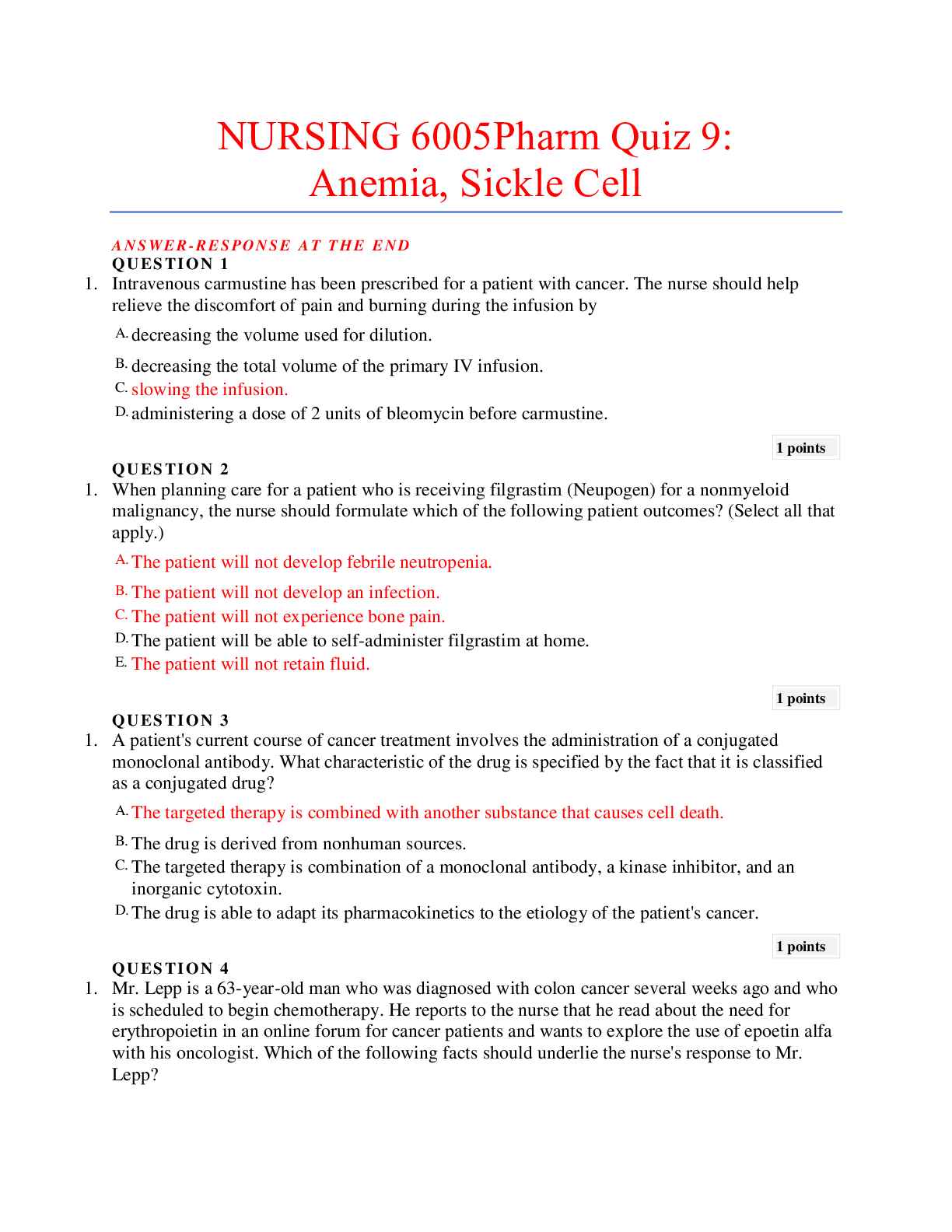
Buy this document to get the full access instantly
Instant Download Access after purchase
Add to cartInstant download
We Accept:

Reviews( 0 )
$9.00
Document information
Connected school, study & course
About the document
Uploaded On
Jul 12, 2020
Number of pages
18
Written in
Additional information
This document has been written for:
Uploaded
Jul 12, 2020
Downloads
0
Views
43













